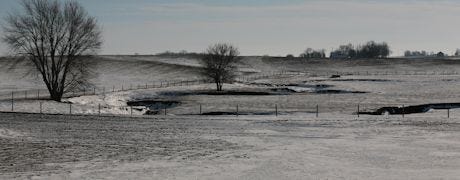March 24, 2013

How have Iowa's hay and pasture stands survived the winter? You'll need to start checking pretty soon, as things begin to green up. "Evaluating forage stands for signs of winter injury should be a regular management practice," says Steve Barnhart, Iowa State University Extension forage agronomist. "But this year, considering how the drought last summer hurt hay crops and pastures, you need to pay special attention." He provides the following guidelines for stand evaluation and management considerations.

EVALUATE FOR WINTER INJURY: As things start to green up soon, ISU Extension forage agronomist Steve Barnhart reminds producers to take a close look at their hay and pasture stands for signs of winter injury. He offers guidelines on stand evaluation and management. Evaluating hay and pasture stands for winter injury should be a regular management practice, but with the drought crippling forage stands last year, it's especially important to evaluate forage stands this spring.
Winter-dormant perennial forage plants remain dormant as long as temperatures in the 'crown' area, or upper few inches of the soil, remain between about 0 and 35 degrees F. Snow cover and residual vegetative cover help to insulate the soil and stabilize soil and crown temperatures. Under ideal conditions, as spring temperatures warm through March, the plants 'break dormancy' and regrow normally into the spring.
Winter injury and winter kill can occur under several conditions: if there is no snow cover and crown temperatures go much below 0 degrees F; when mid-winter 'warm spells' cause the plants to 'break dormancy' early and are then more susceptible to late-winter cold crown temperatures; and, when plants are submerged in frozen, ponded water in low-lying areas during the winter.
How well did forage plants handle the localized, frozen, ponded areas?
This winter, the crown temperatures have likely not been cold enough for direct cold injury, even without snow cover. While day temperatures have been warmer than normal for short periods through February and early March, night temperatures have, hopefully, been cold enough to prevent the plants from breaking dormancy. A significant concerns are the localized, frozen, ponded areas. How well did they handle this winter? It is time to go find out.
* Stand evaluation. When evaluating alfalfa in late winter for winter injury, consider both the number of plants per square foot and, for alfalfa, the age of the stand. Crown and root diseases also have a major effect on stand reduction of legumes, so plants should be checked for dead, dying or diseased crown and root tissue. Winter-injured plants may survive satisfactorily, but are often slow to recover in spring, so a quick decision to destroy a winter injured stand is not recommended.~~~PAGE_BREAK_HERE~~~
Wait until the spring regrowth is about 3 to 4 inches high. Select random stand count sites. Check at least one 1-square-foot site for every 5 to 10 acres. Dig up all of the plants in the 1-square-foot area. Inspect for new growth and the crown and buds to determine if the tissue is still alive. Then count the number of live plants per square foot. Use Table 1 which accompanies this article to begin your rating of the stand.
* Split some taproots and take a look. Next, split the taproots lengthwise with a knife and evaluate their general health. The core of a healthy taproot is firm and creamy white. Damaged or dying taproots are yellowish brown to chocolate brown in color and watery or dry and fibrous in texture. Only healthy plants will contribute significantly to yield, so if the taproots are more than 50% diseased, reduce your initial stand count accordingly.
Table 1. Age of alfalfa stand and rating of winter survival
| Good | Marginal* | Consider Reseeding |
| Plants per square foot | ||
Year after seeding | +12 | 8 to 12 | Less than 8 |
2 | +8 | 5 to 6 | Less than 5 |
3** | +6 | 4 to 5 | Less than 4 |
4 and older** | +4 | 3 to 4 | Less than 3 |
* Healthy alfalfa plants in thin stands often produce more individual stems per plant and compensate some in yield potential. ** If 50% or more of the plants have crown or root rot, consider reseeding.
Plan your forage management this season, based on your stand evaluation
If alfalfa stands are winter-injured, but will be harvested this season, allow plants to mature to 10% to 25% bloom or later, before cutting.~~~PAGE_BREAK_HERE~~~
* Increase cutting height to 3 to 4 inches.
* Maintain good fertilizer and insect management.
* If stands are severely winter injured, and you have incurred a significant loss to planned stored forage, plan to re-establish a new hayfield this spring and begin to plan for any needed supplemental harvested and stored forage needed until the new seeding becomes adequately productive.
* Assess red clover stands similarly.
* What about forage grasses? Overwintering perennial forage grasses often survive better than winterhardy legumes. However, orchardgrass and ryegrasses are more susceptible to winter injury. Visual evaluation of grass regrowth and vitality of crown tissue is suggested when evaluating winter survival of pastures.
Reseeding in hayfields or pastures might be needed. Reseeding more alfalfa into or immediately after a two year old or older stand is not recommended. Overseeing or drilling grasses or red clover into thin or winter damaged stands should be done from now through April. Delaying seeding increases the risk of weed and surviving forage plant competition and seedling loss to increasingly dry and hot soil surface conditions of early summer.
Refer to these Iowa State University Extension publications for further information:
* Evaluation for winter injury /Publications/PM1362.pdf
* Selecting forage species /Publications/PM1792.pdf
* Establishing new forage stands /Publications/PM1008.pdf
* Interseeding and no-till renovation /Publications/PM1097.pdf
You May Also Like




